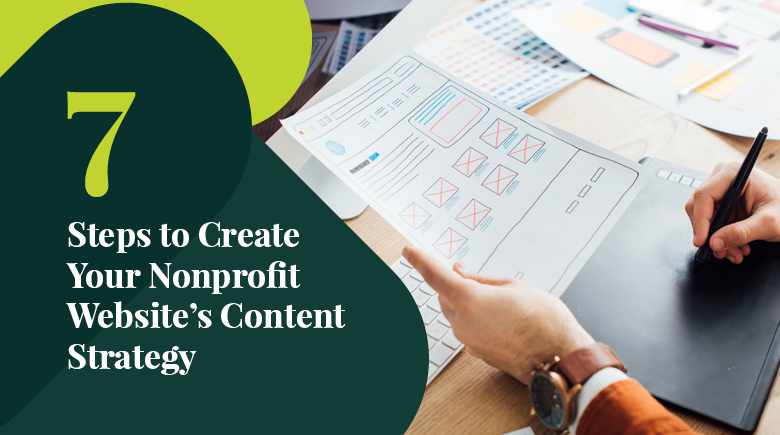7 Steps to Create Your Nonprofit Website’s Content Strategy

Your nonprofit’s website is designed to tell your organization’s story. You chose every aspect of your site deliberately, from the structure to the design and aesthetics. But no effective website is complete without robust content. Your content is why people visit your site!
Your content should go beyond the basics to provide web visitors with a meaningful understanding of your nonprofit’s work and its impact. Developing a clear content strategy is the key to creating a more engaging, valuable nonprofit website.
Follow these seven steps to create a powerful content strategy that drives engagement and conversions:
- Set a goal.
- Define your audience.
- Establish your tone.
- Take a multimedia approach.
- Gather content from a variety of sources.
- Make your content accessible.
- Create an SEO plan.
Your content has the power to create an emotional connection with audience members, motivating them to support your cause. With the right content strategy, you can develop stronger bonds with your audience that lead to long-lasting relationships.
1. Set a goal.
Like any strategy, your content planning strategy should start with a goal.
Before setting your goal, audit your current content. Review your website’s blog posts, educational guides, and other resources to determine what’s worth keeping and what should be eliminated or adapted.
Specifically, look for outdated content that doesn’t represent your brand anymore. Consider archiving or updating these pages to be more relevant. Also, identify content that may be ranking well for search engine optimization (SEO), but hasn’t been updated in a while—these pages are strong candidates for content refreshes.
After reviewing the current state of your content, you’ll be ready to set a goal for your content strategy. Make sure your goal is specific and measurable. Examples of useful goals include:
- Increase website traffic by 50% from one year to the next.
- Increase donation page conversions by 100%.
- Decrease bounce rate by 50% for important pages like your homepage or donation page.
Assign relevant metrics to each goal. For example, you might track donation page conversions, homepage bounce rate, or overall website traffic. Check in on these metrics regularly as you carry out your strategy.
2. Define your audience.
Effective nonprofit web design and development starts with creating content that appeals to your unique audience. Use these strategies to understand your audience and the best ways to connect with them:
- Research your target audience. Understand your target audience’s demographics, motivations, employment status, education levels, and other information that reveals insight into who they are.
- Develop audience personas. Use the information you gathered throughout the research process to develop audience personas for each of the major audience groups you identified. Design your personas using actual names and visuals. For instance, one of your personas might be a 32-year-old working professional named Eliza. Creating full-fledged characters for each of your personas helps you think of them as real people for whom you’re creating marketing materials.
- Align your content to your personas. Develop content that appeals to each of your target personas. Think about the types of content that each persona will respond best to. For instance, one of your personas may prefer watching videos, while others might like to see blog posts with photo essays.
Your content strategy should be driven by your audience’s motivations and interests. Designing content for your unique audience personas helps you develop a website that resonates with visitors.
3. Establish your tone.
Your tone describes your brand’s personality. According to Getting Attention’s guide to nonprofit marketing, “The way you communicate with your supporters is inherently tied to their perception of your organization.” Your tone should be uniform across all digital marketing platforms, from your website to your social media.
To develop your tone, think about the feeling and mood you want to convey to website visitors as they view your content. Here are a few examples of ways you might describe your tone:
- Educational and formal
- Casual and friendly
- Playful and witty
- Candid and straightforward
- Enthusiastic and passionate
Determining the tone that works best for your nonprofit website will help you make decisions about word choice, images, and graphics.
4. Take a multimedia approach.
Your content strategy shouldn’t be one-dimensional. Incorporating a variety of content, from explainer videos to interactive polls, will help engage your audience on multiple levels.
Consider incorporating the following multimedia elements into your content:
- Photos
- Videos
- Gifs
- Interactive charts
- Quizzes
- Polls
Engaging graphic design and interactive elements transform your website from a static informational hub to a dynamic resource. Make sure to use real photos and videos of your constituents, volunteers, and other community members to give your website greater authenticity.
5. Gather content from a variety of sources.
Content generation can come from many different sources. Gathering a variety of audience-generated content can help engage your supporters while providing you with more authentic content for your website.
For example, use your social media pages to ask supporters to send in videos or photos of themselves engaging with your organization. Let’s say you’re generating content for your annual virtual 5K event. You can create social media posts asking participants to send in videos and photos of them participating in the event. Then, you can use those visuals in your event recap blog posts.
Staff members and volunteers can also be great content resources. These individuals can take photos and videos at events and submit them to your organization’s content library. Then, you’ll have a rich visual bank to pull from when creating blog posts and other web content.
6. Make your content accessible.
According to Kanopi’s roundup of the best nonprofit websites, accessibility is one of the most important qualities of a powerful nonprofit site. Web accessibility means that all of your web content is usable and readable for all audiences.
Follow the Web Content Accessibility Guidelines (WCAG) to ensure your nonprofit website content is useful for all site visitors. Here are a few guidelines that are most relevant to your content:
- Include alt text for images.
- Incorporate captions for videos.
- Ensure any auto-playing videos offer pause and mute functionality.
- Ensure sufficient color contrast (to achieve the WCAG level AA, you’ll need to ensure a contrast ratio of at least 4.5:1 for normal text and 3:1 for large text).
- Use simple, clear navigation.
Taking continuous steps to make your content more accessible can expand your reach to diverse audiences and improve the user experience.
7. Create an SEO plan.
The last piece of your content strategy puzzle is promoting your content to reach a wider audience. Creating an SEO plan will allow you to increase the visibility of your content across search engine results pages.
To support your SEO strategy, make sure your content includes the following elements:
- Optimized meta descriptions and meta titles
- Keyword optimization
- Concise, descriptive URLs
- Optimized images
- Fast page load speeds
- Readable sections with subheadings and short paragraphs
For more information about building a strong SEO plan, check out Moz’s SEO Learning Center. This resource offers ideas for taking your SEO beyond the basics to create a savvy strategy that boosts your online traffic.
Lastly, the most important element of your nonprofit’s content strategy is consistency. Consistent posting will help you build an organic audience of engaged blog readers that interact with and share your content. A consistent tone will help establish your nonprofit’s brand and build brand authority. By following these tips and maintaining consistency, you can create a content strategy that benefits your digital presence for years to come.
About the Author
Anne Stefanyk
 As Founder and CEO of Kanopi Studios, Anne helps create clarity around project needs, and turns client conversations into actionable outcomes. She enjoys helping clients identify their problems, and then empowering the Kanopi team to execute great solutions.
As Founder and CEO of Kanopi Studios, Anne helps create clarity around project needs, and turns client conversations into actionable outcomes. She enjoys helping clients identify their problems, and then empowering the Kanopi team to execute great solutions.
Anne is an advocate for open source and co-organizes the Bay Area Drupal Camp. When she’s not contributing to the community or running her thoughtful web agency, she enjoys yoga, meditation, treehouses, dharma, cycling, paddle boarding, kayaking, and hanging with her nephew.
https://twitter.com/Anne_Kanopi


